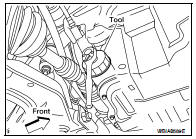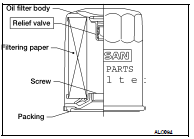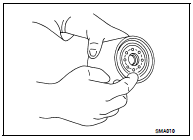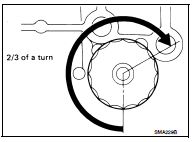Nissan Altima (L32) 2007-2012 Service Manual: Oil filter
Removal and Installation
REMOVAL
1. Remove the oil filter using Tool.
Tool number : KV10115801 (J-38956)
WARNING:
• Be careful not to get burned, the engine and engine oil
may be hot.
CAUTION:
• When removing, prepare a shop cloth to absorb any oil
leakage or spillage.
• Do not allow engine oil to adhere to the drive belts.
• Completely wipe off any oil that adheres to the engine and
the vehicle.
• The oil filter has a built in pressure relief valve. Use a genuine
NISSAN oil filter or equivalent
INSTALLATION
1. Remove foreign materials adhering to the oil filter installation surface.
2. Apply clean engine oil to the oil seal contact surface of the new
oil filter.
3. Screw the oil filter manually until it touches the installation surface,
then tighten it by 2/3 turn. Or tighten to specification below.
Oil filter : 18.0 N·m (1.8 kg-m, 13 ft-lb)
4. Check oil level and add engine oil as necessary. Refer to LU-9.
5. After warming up the engine, check for any engine oil leaks.
Inspection
OIL LEVEL
• Before starting the engine, check the oil level. If the engine is
already started, stop it and allow 10 minutes before checking.
• Check that the oil level is within ...
Other materials: Head restraints/headrests
WARNING
Head restraints/headrests supplement
the other vehicle safety systems. They
may provide additional protection
against injury in certain rear end collisions.
Adjustable head restraints/
headrests must be adjusted properly,
as specified in this section. Check the
adjustment after someone else ...
Engine compartment check locations
2.0L 4 cylinder (KR20DDET engine model)
Engine coolant reservoir
Drive belt location
Engine oil filler cap
Brake fluid reservoir
Battery
Fuse/Fusible link box
Air cleaner
Radiator cap
Engine oil dipstick
Windshield-washer fluid reservoir
Refer to the page number indicated in
parenth ...
Cleaning exterior
In order to maintain the appearance of
your vehicle, it is important to take proper
care of it.
To protect the paint surfaces, wash your
vehicle as soon as you can:
After a rainfall to prevent possible damage
from acid rain.
After driving on coastal roads.
When contaminants such as soot, bird
...





 Engine oil
Engine oil On-vehicle repair
On-vehicle repair